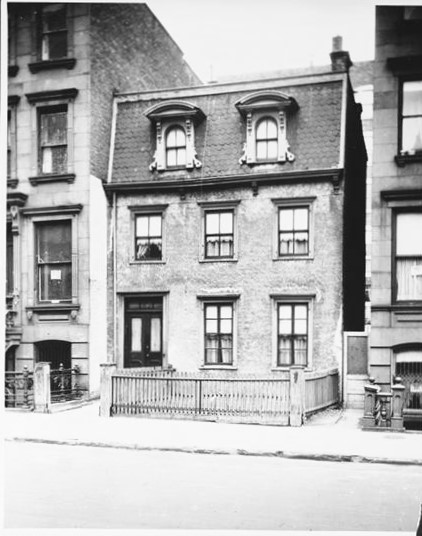
In the heart of Harlem, at 65 West 128th Street, once stood a house that witnessed the neighborhood’s transformation from a rural outpost to the cultural capital of Black America.
This is the story of that house and the lives it touched over nearly eight decades.
The tale begins with John B. Porcher, born in 1823 and appointed as a New York City policeman in 1858. Porcher, along with his wife Catharine, saw an opportunity in Harlem’s real estate during the Civil War.
In 1862, they moved into a newly-built three-story house at 65 West 128th Street, one of several properties Porcher had acquired in the area.
The house itself was a testament to the changing times. Designed in the emerging Second Empire style, it boasted 14 rooms and a fashionable slate-tiled mansard roof.
With its arched pediments, carved brackets, and decorative scrolls, the house straddled the line between sophisticated urban dwelling and country retreat, complete with a wooden picket fence and a narrow horse-walk leading to the rear yard.
As Harlem grew, so did the Porcher family’s fortunes. They moved to another property down the block in 1870, leasing No. 65 to a series of tenants.
The house bore witness to life’s joys and sorrows: it hosted the wedding of the Porchers’ daughter Kate in 1879, but also saw the tragic death of a young tenant, Maggie Johnson, in 1872.
The parade of tenants at 65 West 128th Street reflected Harlem’s evolving social fabric. From newlyweds to working-class families, the house accommodated a cross-section of society.

Oliver B. Jenkins, a mason, and George Sloterman, a carpenter, lived there in the late 1870s, while George Hall, a city parkkeeper earning $2.75 per day, called it home in the mid-1880s.
The Porcher family’s return to the house in 1893 marked a period of stability and prosperity. Their comfortable lifestyle was evident in newspaper announcements of their summer vacations and social events.
In 1897, John and Catherine celebrated their 50th wedding anniversary in the house, both at the age of 73. As the new century dawned, the Porchers moved once again, but continued to lease the property. Their most notable tenants were the McKeever family, including John T. McKeever, a well-known figure in New York’s theatrical circles. McKeever’s untimely death in 1902 marked another somber chapter in the house’s history.
The years that followed saw 65 West 128th Street transition from a single-family home to a rooming house, mirroring the broader changes in Harlem.
RELATED: Check out more Harlem History on our Harlem History Facebook page.
Middle-class tenants sought work through newspaper advertisements, highlighting the economic challenges of the time.
The sale of the house in 1918, after 56 years of Porcher family ownership, coincided with Harlem’s demographic shift. By 1924, the once-grand home was described as a tenement, its decline paralleling the neighborhood’s changing fortunes.
The story of the Fereira family in 1923 poignantly illustrates the struggles faced by Harlem’s residents during this period.
Portuguese immigrants John and Mary Fereira, along with their three young children, fell victim to influenza and poverty, their plight drawing attention to the harsh realities of tenement life.
As Harlem became the epicenter of Black culture in New York, 65 West 128th Street reflected this transformation.
The Fowler family’s residence in 1927 coincided with one of the most violent periods in Harlem’s history, as evidenced by the tragic death of Eugene Fowler Sr. in 1925.
The house’s final years mirrored Harlem’s broader struggles. An unsafe building violation in 1939 led to its demolition, marking the end of an era.

However, in a twist of fate that echoes Harlem’s resilience, the vacant lot was transformed in 1965 into New York City’s first “vest-pocket park,” named after Rev. Linnette C. Williamson.
The story of 65 West 128th Street is more than just the tale of a single house. It’s a microcosm of Harlem’s journey through joy and sorrow, prosperity and hardship, integration and segregation.
From its birth as a symbol of middle-class aspiration to its rebirth as a community space, this address encapsulates the ever-evolving spirit of Harlem – a neighborhood that has always found ways to reinvent itself, even in the face of adversity.
1) While the caption of this photograph in the collection of the Museum of the City of New York and dated ca. 1877 reads, “Home of John B. Porcher, 65 West 128th Street,” it is most likely 51 West 128th Street. The well-dressed gentleman may be Porcher. photographer unknown. 2) from the collection of the New York Public Library. 3) In 1932, 65 West 128th Street (to the left) was overshadowed by its taller neighbors. from the collection of the New York Public Library.4) image via williamsonparks.org.
Become a Harlem Insider!
By submitting this form, you are consenting to receive marketing emails from: . You can revoke your consent to receive emails at any time by using the SafeUnsubscribe® link, found at the bottom of every email. Emails are serviced by Constant Contact










